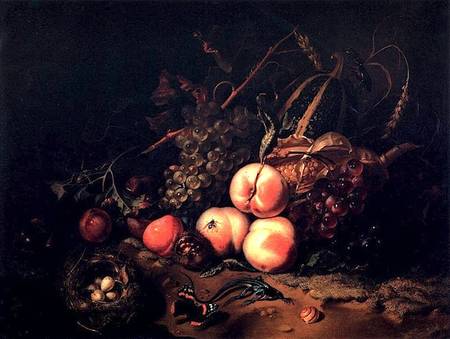Alta Macadam, author of Blue Guide Florence, pays a visit to the newly-opened Blue Rooms at the Uffizi.
Florence’s Galleria degli Uffizi has been undergoing renovation and expansion since the State Archives left the building in 1989, releasing a vast new exhibition space on the piano nobile. When the ‘Grandi Uffizi’ are finally completed, more than twice the present number of paintings will be on show and double the number of visitors admitted. However, work has progressed agonizingly slowly. The exit itself at the back of the building is still awaiting the embellishment (or, many would say, the encumbrance) of a vast structure designed by Arata Isozaki in 1998—if funding from central government is ever forthcoming. Meanwhile, there is a feeling of neglect throughout the gallery and the general atmosphere provided by the staff is not the most welcoming.
But we should at least be grateful that the Tribuna has been restored and, over the last few months, two sets of rooms on the piano nobile have been opened for the first time. The Uffizi now has an excellent website, where you can take a virtual tour of the entire gallery, room by room and painting by painting.
The first rooms to be opened (in May of this year), marked on the plan on the website as the ‘Sale Blu’, house non-Italian paintings, mostly of the 17th–18th centuries. The rooms take their name from their bright blue walls. Unfortunately there are no windows, and one wishes they were bigger. The Flemish and Dutch schools are particularly well represented by numerous small works (many of which were already on show at the Uffizi by the 18th century). Ever since the 15th century, Flemish painting was well known in Florence—the huge Portinari triptych (today exhibited in the Botticelli room) was shipped from Bruges to Florence in 1483 after it had been commissioned there by the Florentine merchant Portinari. Some two centuries later, the future Medici grand duke Cosimo III acquired a number of small Dutch paintings while in Holland. These included Gerrit Dou’s self-portrait (now in Room 47) together with a genre scene by the same artist and six works by the less well-known Dutch artist Frans van Mieris the Elder (1635–81), who was most particularly admired by Cosimo. Also displayed in this room are an interior by Gabriel Metsu and a scene in a country inn by Jan Steen. In Room 49 are some famous portraits by Rembrandt. Two of the forty or so self-portraits he painted throughout his life are hung here: as a proud young man in armour sporting a hat, and then as a rather pathetic, very old man. His portrait of a bearded rabbi is signed and dated. The large landscape by Hercules P. Seghers is known to have been admired by Rembrandt (and there is a fascinating hypothesis that he might even have had a hand in painting the sky): curiously enough, it was donated to the last Lorraine grand duke, Leopold II, by an English lady called Hatfield who ran a pensione on the Lungarno Guicciardini. There are two still lifes here by Rachel Ruysch, one of the few women painters of the time: she managed to paint some 100 works in her long life (she lived to be almost 100), as well as giving birth to 19 children. Also here is an idyllic landscape by Adriaen van der Velde and a view of a square in Amsterdam by Jan van der Heyden. In Room 50 are 17th-century works by Godfried Schalcken, lit by candlelight, including his self-portrait commissioned by Cosimo III in 1694. Room 53 has works by Adriaen van der Werff (who was famous in his own lifetime; less so now). In Room 54 there is a self-portrait by the little-known Dutch painter Gerrit Adrianensz Berckheyde (an intriguing work, it includes another self-portrait, shown hanging on the wall behind the sitter). The landscapes here are by Cornelis van Poelenburgh, Dirk van Berghen and Jacob van Ruysdael. It is interesting to note that all the imitation Dutch ebony frames were made in Florence much later, during the 19th century.

The Flemish school is well represented (in Room 52) by Paul Bril (Seascape), David Teniers the Younger (The Butcher’s Shop), and by two allegories attributed to Jan Brueghel the Younger. More 17th-century Flemish works are displayed in the largest room (55), where Rubens is represented by a self-portrait (which, however, is not apparently entirely by his own hand) and also by the fine portrait of his first wife, Isabella Brandt. There are also a number of late portraits by Van Dyck. Daniel Seghers, whose particular skill was in representing flowers, painted the lovely garland encircling a bust of the grand duke Leopold.
There are also two rooms of French paintings (dating from the 17th and 18th centuries and acquired at the end of the 18th). The later works include portraits of Vittorio Alfieri and the Countess of Albany by François-Xavier Fabre; Marie-Adelaide of France in Turkish costume by Jean-Etienne Liotard (whose self-portrait also hangs here); and two delightful portraits of children by Chardin. Another room is devoted to the Spanish school, poorly represented elsewhere in Florence: it is dominated by a superb large portrait of the Countess of Chinchón by Goya. St John the Evangelist and St Francis is a typical work (signed) by El Greco. The self-portrait by Velázquez was brought to Florence from Düsseldorf by Anna Maria Luisa, sister of the last Medici grand duke.






